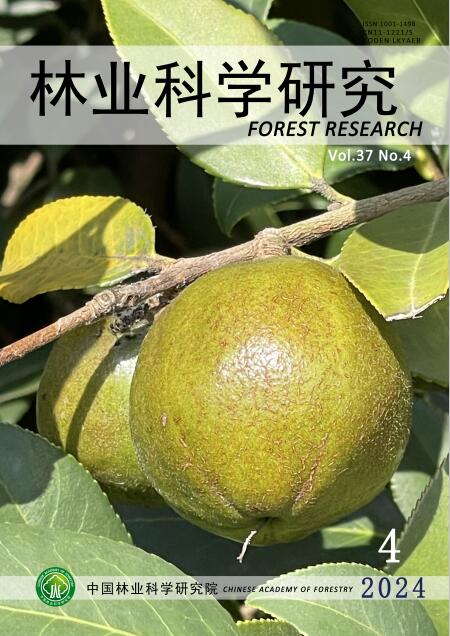间伐和焚烧恢复对杰弗里松林分叶片和土壤元素的影响
Q4 Agricultural and Biological Sciences
引用次数: 0
摘要
对东部西弗瑞松(Pinus jeffreyi Grev)的矿物质营养的影响进行了评估,评估方法是通过切割和整树采伐,然后进行规定的下烧。& Balf)。从分布在三个生长季节的6个样品的叶面元素浓度得出,Ca/Al、Mg/Al、K/Al、Ca/Mn、Mg/Mn和K/Mn的摩尔浓度在未疏伐处理中普遍较高,而在烧毁的林分部分则较低。在干旱条件下进行的研究中,各处理的平均Ca/Al、Mg/Al和K/Al较低,Ca/Mn和Ca/Zn较高。叶面K/Mn、K/Zn和K/Cu在生长季前期普遍低于生长季后期。生长中期,幼针的Mg/Al、K/Al、Mg/Mn、K/Mn、K/Fe、K/Zn和K/Cu较高,老针的Ca/Al、Ca/Fe、Mg/Fe、Ca/Zn、Ca/Cu和Mg/Cu较高。在研究中期,未疏伐处理的土壤Ca/Fe总体较高,其中未烧伐部分较高,而K/Cu总体较高,其中以未疏伐处理最高。这些发现有助于深入了解受恢复措施影响的森林营养中碱阳离子和金属元素的相互关系。本文章由计算机程序翻译,如有差异,请以英文原文为准。
Elemental Ratios in Foliage and Soil of a Jeffrey Pine Stand Subjected to Thinning and Burning Restoration Practices
Forest thinnings accomplished through cut-to-length and whole-tree harvesting followed by a prescribed underburn were assessed for their influences on mineral nutrition in eastern Sierran Jeffrey pine (Pinus jeffreyi Grev. & Balf.). As derived from foliar elemental concentrations determined at six samplings distributed over three growing seasons, molar Ca/Al, Mg/Al, K/Al, Ca/Mn, Mg/Mn, and K/Mn were generally higher in the unthinned treatment and lower in burned stand portions. Conducted under drought conditions, the driest phase of the study resulted in lower Ca/Al, Mg/Al, and K/Al and higher Ca/Mn and Ca/Zn when averaged across treatments. Foliar K/Mn, K/Zn, and K/Cu were generally lower in the early portion of the growing season compared to the late portion. At mid growing season, Mg/Al, K/Al, Mg/Mn, K/Mn, K/Fe, K/Zn, and K/Cu were higher in young needles while Ca/Al, Ca/Fe, Mg/Fe, Ca/Zn, Ca/Cu, and Mg/Cu were so in older ones. At mid study, soil Ca/Fe was higher in the unthinned treatment generally and especially in its unburned portion while K/Cu was higher overall in burned stand portions, most especially in the unthinned treatment. These findings provide insight into the interrelationships of base cations and metallic elements in forest nutrition as influenced by restoration practices.
求助全文
通过发布文献求助,成功后即可免费获取论文全文。
去求助
来源期刊

林业科学研究
Environmental Science-Ecology
CiteScore
0.90
自引率
0.00%
发文量
4834
期刊介绍:
Forestry Research is a comprehensive academic journal of forestry science organized by the Chinese Academy of Forestry. The main task is to reflect the latest research results, academic papers and research reports, scientific and technological developments and information on forestry science mainly organized by the Chinese Academy of Forestry, to promote academic exchanges at home and abroad, to carry out academic discussions, to flourish forestry science, and to better serve China's forestry construction.
The main contents are: forest seeds, seedling afforestation, forest plants, forest genetic breeding, tree physiology and biochemistry, forest insects, resource insects, forest pathology, forest microorganisms, forest birds and animals, forest soil, forest ecology, forest management, forest manager, forestry remote sensing, forestry biotechnology and other new technologies, new methods, and to increase the development strategy of forestry, the trend of development of disciplines, technology policies and strategies, etc., and to increase the forestry development strategy, the trend of development of disciplines, technology policies and strategies. It is suitable for scientists and technicians of forestry and related disciplines, teachers and students of colleges and universities, leaders and managers, and grassroots forestry workers.
 求助内容:
求助内容: 应助结果提醒方式:
应助结果提醒方式:


